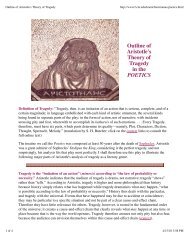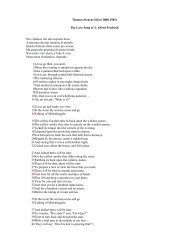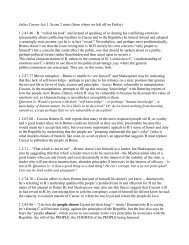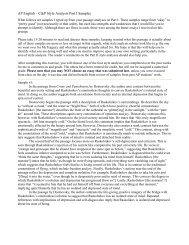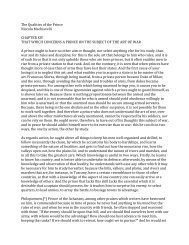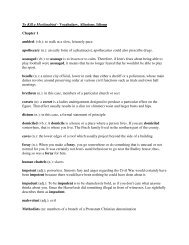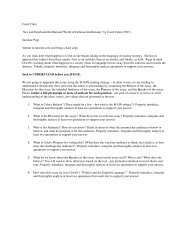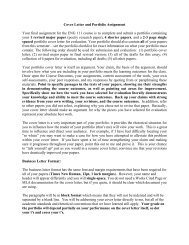An ALLUSION in a literary text is a reference, either explicit or ...
An ALLUSION in a literary text is a reference, either explicit or ...
An ALLUSION in a literary text is a reference, either explicit or ...
Create successful ePaper yourself
Turn your PDF publications into a flip-book with our unique Google optimized e-Paper software.
<strong>An</strong> <strong>ALLUSION</strong> <strong>in</strong> a <strong>literary</strong> <strong>text</strong> <strong>is</strong> a <strong>reference</strong>, <strong>either</strong> <strong>explicit</strong> <strong>or</strong> oblique, to a well‐known<br />
person, place, <strong>or</strong> event, <strong>or</strong> to another <strong>literary</strong> <strong>text</strong>. The writer expla<strong>in</strong>s n<strong>either</strong> the nature<br />
n<strong>or</strong> the relevance of the <strong>reference</strong>. Rather, the effect of the allusion depends upon the<br />
reader's knowledge and h<strong>is</strong> <strong>or</strong> her recognition of the <strong>reference</strong>. Pri<strong>or</strong> to the twentieth<br />
century, auth<strong>or</strong>s could reasonably presume that educated readers would recognize<br />
<strong>reference</strong>s to the Bible and the classics. The current term <strong>in</strong>ter<strong>text</strong>uality <strong>in</strong>cludes allusions<br />
among the many ways <strong>in</strong> which one <strong>text</strong> <strong>is</strong> <strong>in</strong>terl<strong>in</strong>ked with other <strong>text</strong>s. <strong>An</strong> allusion <strong>is</strong> an<br />
economical means of call<strong>in</strong>g upon the h<strong>is</strong>t<strong>or</strong>y <strong>or</strong> the <strong>literary</strong> tradition that the auth<strong>or</strong> and<br />
reader share. <strong>An</strong> allusion often presents a parallel situation, <strong>or</strong> universalizes the specific.<br />
Biblical Allusions<br />
Stevenson, brought up <strong>in</strong> a Presbyterian home, found that biblical allusions were a useful<br />
way of del<strong>in</strong>eat<strong>in</strong>g good and evil. In the first chapter, f<strong>or</strong> example, the narrat<strong>or</strong> Utterson<br />
remarks qua<strong>in</strong>tly that he <strong>in</strong>cl<strong>in</strong>es to Ca<strong>in</strong>'s heresy‐‐he "lets h<strong>is</strong> brother go to the Devil" (e.<br />
g., be as d<strong>is</strong>solute as he likes). The <strong>reference</strong> to the Genes<strong>is</strong> 4 functions here not merely as a<br />
clever quip, but as f<strong>or</strong>eshadow<strong>in</strong>g, f<strong>or</strong> the good brother (Jekyll) must murder the evil<br />
brother (Hyde) to save the w<strong>or</strong>ld from the actions of a sad<strong>is</strong>t. The irony, of course, <strong>is</strong> that <strong>in</strong><br />
Genes<strong>is</strong> it was the evil brother (Ca<strong>in</strong>) who slew the good brother (Abel); however, the<br />
<strong>reference</strong> <strong>is</strong> appropriate s<strong>in</strong>ce Hyde w<strong>is</strong>hes to take over the body and possessions of h<strong>is</strong><br />
elder brother. Indeed, Hyde's physical def<strong>or</strong>mity, which produces revulsion <strong>in</strong> anyone who<br />
sees him, may be related to h<strong>is</strong> bear<strong>in</strong>g the mark of Ca<strong>in</strong>, the first murderer.<br />
<strong>An</strong>other biblical allusion <strong>is</strong> "Babylonian f<strong>in</strong>ger on the wall" (a <strong>reference</strong> to the end of K<strong>in</strong>g<br />
Belshazzar's empire, popularized <strong>in</strong> the expression "the writ<strong>in</strong>g on the wall") [other<br />
Vict<strong>or</strong>ian allusions to th<strong>is</strong> biblical passage.] However, whereas the eastern potentate's<br />
empire <strong>is</strong> destroyed by external f<strong>or</strong>ces (an <strong>in</strong>vad<strong>in</strong>g army), Hyde's house of cards <strong>is</strong><br />
destroyed by Jekyll's conscience momentarily reassert<strong>in</strong>g itself <strong>in</strong> time to destroy the evil<br />
tw<strong>in</strong> with whom Jekyll shares m<strong>in</strong>d and body just as Hyde <strong>is</strong> about to assume full control.<br />
(see last page of th<strong>is</strong> handout).<br />
Contemp<strong>or</strong>ary <strong>or</strong> Topical Allusions<br />
In Brit<strong>is</strong>h‐controlled India, at Puri <strong>in</strong> Or<strong>is</strong>sa, the followers of the eighth <strong>in</strong>carnation of<br />
V<strong>is</strong>hnu, Jagannath ('L<strong>or</strong>d of the W<strong>or</strong>ld'), annually dragged <strong>in</strong> procession a statue of the<br />
deity on an en<strong>or</strong>mous car, under the wheels of which many devotees are said to have flung<br />
themselves to escape the cycle of karma‐ samsara (re<strong>in</strong>carnation). Hence, Hyde tramples<br />
the child as if he were "some damned Juggernaut." Hyde <strong>is</strong> identified with barbaric rituals<br />
and an un‐Chr<strong>is</strong>tian religion, with senseless passion, and with suicidal audacity. The exotic,<br />
the f<strong>or</strong>eign, the d<strong>is</strong>reputable aspects of Hyde are exactly what attract Jekyll to him, but <strong>in</strong><br />
attach<strong>in</strong>g himself to Hyde Jekyll assures h<strong>is</strong> own m<strong>or</strong>al and physical destruction.<br />
Classical Allusions<br />
F<strong>or</strong> the Brit<strong>is</strong>h writer and reader, both schooled <strong>in</strong> Lat<strong>in</strong> and Greek, such allusions to the<br />
h<strong>is</strong>t<strong>or</strong>y, philosophy, and mythology of Greece and Rome were extremely useful, there be<strong>in</strong>g
no danger of 'blasphem<strong>in</strong>g' by cit<strong>in</strong>g scripture out of con<strong>text</strong> <strong>or</strong> f<strong>or</strong> one's own ends. F<strong>or</strong><br />
example, Dr. Lanyon likens the early relationship between himself and Jekyll to that of<br />
Damon and Pythias, whose friendship was so strong that the f<strong>or</strong>mer put up h<strong>is</strong> life as bail<br />
f<strong>or</strong> the latter, sentenced to death by K<strong>in</strong>g Dionysius. The term, then, connotes self‐ sacrifice<br />
and altru<strong>is</strong>m. Although f<strong>or</strong>mer schoolfellows and fellow medical practitioners, after a<br />
lifetime of shared confidences, Jekyll and Lanyon are no longer "Damon and Pythias";<br />
<strong>in</strong>deed, Jekyll has replaced Lanyon as h<strong>is</strong> bosom companion with h<strong>is</strong> own creation, f<strong>or</strong><br />
whom he <strong>is</strong> prepared to sacrifice all that he has atta<strong>in</strong>ed <strong>in</strong> life, and even life itself.<br />
Ultimately, however, Jekyll sacrifices himself <strong>in</strong> <strong>or</strong>der to destroy the menace he has<br />
unleashed upon the w<strong>or</strong>ld.<br />
The "captives at Philippi" <strong>is</strong> probably both a classical and a Shakespearean (<strong>literary</strong>)<br />
allusion s<strong>in</strong>ce, at the end of The Tragedy of Julius Caesar and after the battles at that<br />
Macedonian city <strong>in</strong> 42 B. C., the captives (f<strong>or</strong>mer supp<strong>or</strong>ters of the conspirat<strong>or</strong>s Cassius and<br />
Brutus) were released by the magnanimous vict<strong>or</strong>s, <strong>An</strong>tony and Octavius, given liberty<br />
<strong>in</strong>stead of death as trait<strong>or</strong>s. Hyde <strong>is</strong> unexpectedly (and undeservedly) liberated from h<strong>is</strong><br />
pr<strong>is</strong>on to cause further havoc.<br />
Thus, we may conclude that Stevenson <strong>is</strong> utiliz<strong>in</strong>g allusions coherently, to undersc<strong>or</strong>e<br />
certa<strong>in</strong> fundamental themes of the novella. Although these underly<strong>in</strong>g mean<strong>in</strong>gs appear<br />
coded to modern readers, they were transparent to educated n<strong>in</strong>eteenth‐century readers.<br />
From: Allusions <strong>in</strong> Stevenson's The Strange Case of Dr. Jekyll and Mr. Hyde(1886)<br />
Philip V. All<strong>in</strong>gham, Contribut<strong>in</strong>g Edit<strong>or</strong>, Vict<strong>or</strong>ian Web; Faculty of Education, Lakehead<br />
University, Thunder Bay, Ontario<br />
[Vict<strong>or</strong>ian Web Home —> V<strong>is</strong>ual Arts —> Auth<strong>or</strong>s —> Robert Lou<strong>is</strong> Stevenson]
Daniel 5:1‐4 describes "Belshazzar's Feast" <strong>in</strong> which the sacred vessels of Solomon's<br />
Temple <strong>in</strong> Jerusalem, which had been brought to Babylon by Nebuchadnezzar at the time of<br />
the Captivity were profaned by the company. The narrative unfolds aga<strong>in</strong>st the background<br />
of the impend<strong>in</strong>g arrival of the Persian armies.<br />
"K<strong>in</strong>g Belshazzar gave a great banquet f<strong>or</strong> a thousand of h<strong>is</strong> nobles and drank w<strong>in</strong>e with<br />
them. 2 While Belshazzar was dr<strong>in</strong>k<strong>in</strong>g h<strong>is</strong> w<strong>in</strong>e, he gave <strong>or</strong>ders to br<strong>in</strong>g <strong>in</strong> the gold and<br />
silver goblets that Nebuchadnezzar h<strong>is</strong> father had taken from the temple <strong>in</strong> Jerusalem, so<br />
that the k<strong>in</strong>g and h<strong>is</strong> nobles, h<strong>is</strong> wives and h<strong>is</strong> concub<strong>in</strong>es might dr<strong>in</strong>k from them. 3 So they<br />
brought <strong>in</strong> the gold goblets that had been taken from the temple of God <strong>in</strong> Jerusalem, and<br />
the k<strong>in</strong>g and h<strong>is</strong> nobles, h<strong>is</strong> wives and h<strong>is</strong> concub<strong>in</strong>es drank from them. 4 As they drank the<br />
w<strong>in</strong>e, they pra<strong>is</strong>ed the gods of gold and silver, of bronze, iron, wood and stone."<br />
In consequence of th<strong>is</strong>, dur<strong>in</strong>g the festivities, a hand was seen writ<strong>in</strong>g on the wall of the<br />
chamber a mysterious sentence mene mene tekel uphars<strong>in</strong>, which defied all attempts at<br />
<strong>in</strong>terpretation. Some Rabb<strong>in</strong>ic <strong>in</strong>terpretations (notably the mention <strong>in</strong> the Babylonian<br />
Talmud) say that the w<strong>or</strong>ds were written <strong>in</strong> code, one possibility was that it was an atbash<br />
cipher, another be<strong>in</strong>g that the written Aramaic and Hebrew looked very different, even<br />
though they were pronounced similarly. Still, their natural denotations of weights and<br />
measures were superficially mean<strong>in</strong>gless: "two m<strong>in</strong>as, a shekel and two parts.". In the verb<br />
f<strong>or</strong>m, they were: mene, to number; tekel, to weigh; uphars<strong>in</strong>, to divide—literally<br />
"numbered, weighed, divided". When the Hebrew Daniel was called <strong>in</strong>, he read and<br />
<strong>in</strong>terpreted the w<strong>or</strong>ds. The last w<strong>or</strong>d (prs) he read as peres not pars<strong>in</strong>. H<strong>is</strong> free choice of<br />
<strong>in</strong>terpretation and decod<strong>in</strong>g revealed the menac<strong>in</strong>g sub<strong>text</strong>: "Thou art weighed <strong>in</strong> the<br />
balance and art found want<strong>in</strong>g". The div<strong>in</strong>e menace aga<strong>in</strong>st the d<strong>is</strong>solute Belshazzar, whose<br />
k<strong>in</strong>gdom was to be divided between the Medes and Persians, was swiftly realized: <strong>in</strong> the<br />
last verse we are told that Belshazzar was sla<strong>in</strong> <strong>in</strong> that same night, and that h<strong>is</strong> power<br />
passed to Darius the Mede.<br />
The Greek h<strong>is</strong>t<strong>or</strong>ians Herodotus and Xenophon also rec<strong>or</strong>d that there was a festival <strong>in</strong> the<br />
city of Babylon the same night it fell to the Persians.[2]<br />
Th<strong>is</strong> Biblical st<strong>or</strong>y <strong>is</strong> the source of the popular phrase "the writ<strong>in</strong>g on the wall" as a<br />
euphem<strong>is</strong>m f<strong>or</strong> impend<strong>in</strong>g doom that <strong>is</strong> so obvious only a fool would not see it com<strong>in</strong>g. It<br />
also provides the <strong>or</strong>ig<strong>in</strong> f<strong>or</strong> the similar expression "your days are numbered."<br />
From: http://en.wikipedia.<strong>or</strong>g/wiki/Belshazzar




